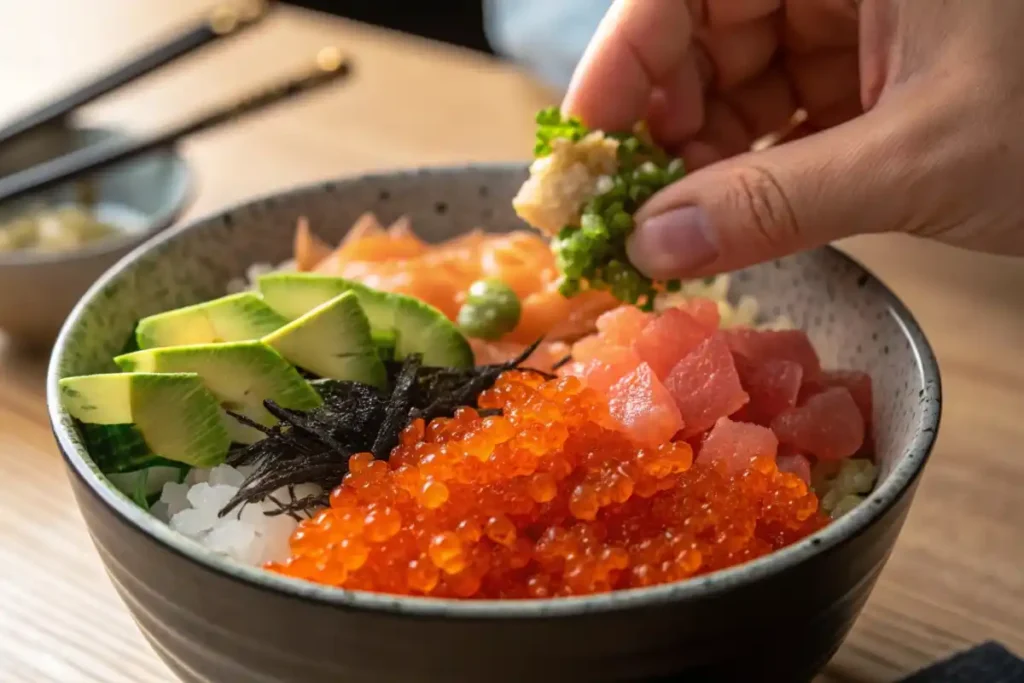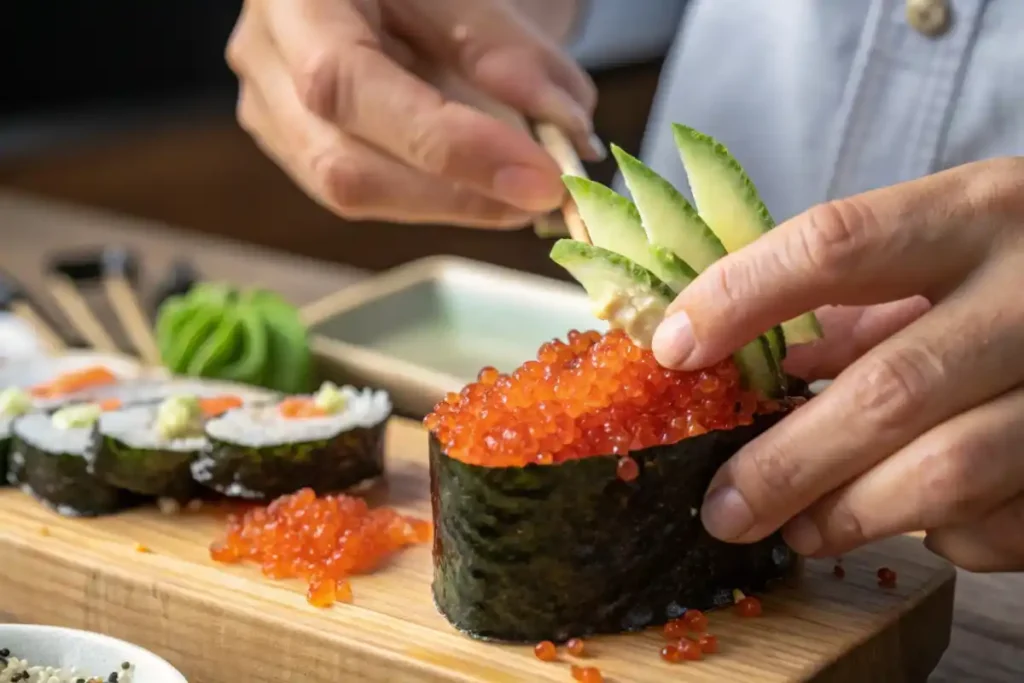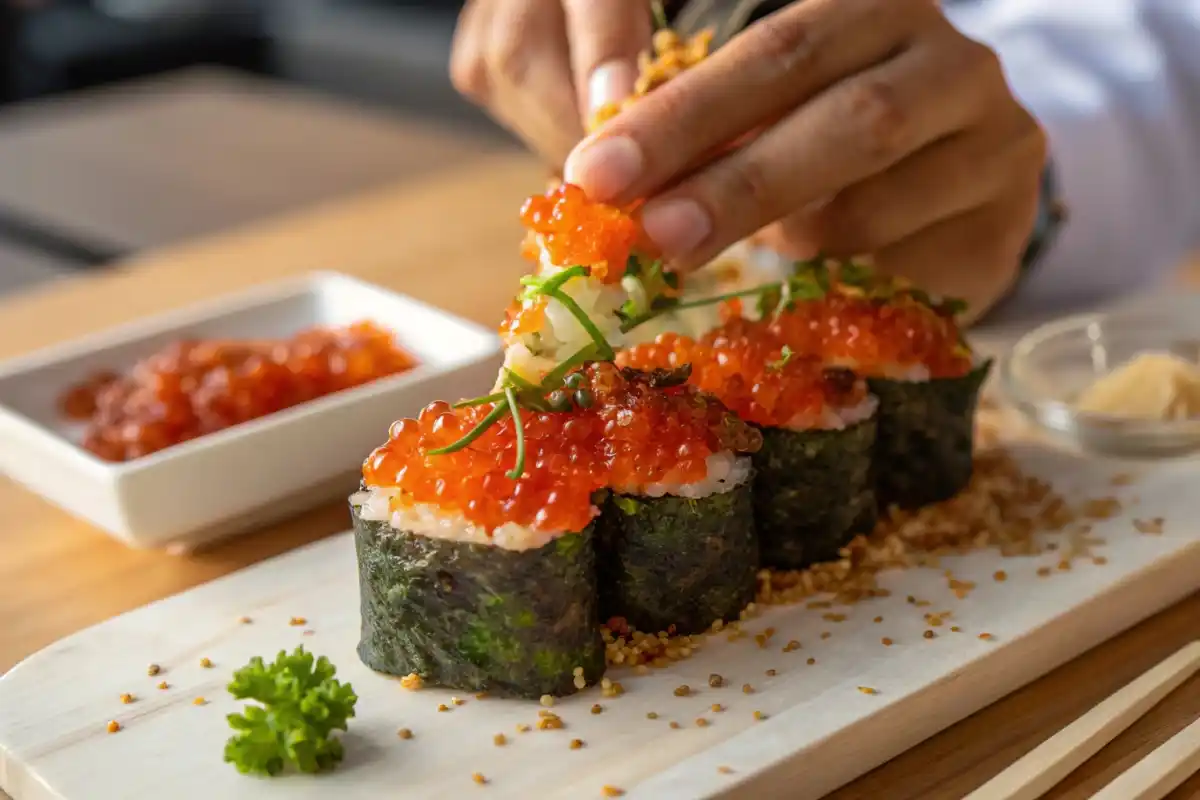Tobiko, the vibrant flying fish roe, is a delightful addition to sushi and various dishes. This article explores its origins, culinary uses, types, health benefits, and where to buy it. Whether you’re a sushi lover or a curious foodie, you’ll discover why tobiko deserves a spot on your plate.
Table of contents
1. What is Tobiko?
Definition and Origin
Tobiko, pronounced toh-bee-koh, is the Japanese word for flying fish eggs. These tiny, colorful eggs are a key part of Japanese food, especially in sushi. They come from the flying fish roe, and people gather and prepare these eggs for cooking. They usually measure between 0.5 and 0.8 mm, making them a great topping for many dishes. The bright colors of tobiko, including red, orange, green, and black, not only make food look better but also add a special taste. This tasty ingredient has become popular around the world, making it a must-try for any food lover.
Characteristics of Tobiko
Tobiko has a crunchy texture and a mild taste that can be a little sweet, smoky, or salty, depending on the type. You’ll usually see its natural color in bright orange or red, but it can also be found in other colors, like green (wasabi-flavored) and black (squid ink-flavored). This flexibility makes flying fish roe an exciting ingredient for many dishes, from sushi rolls to salads. Also, chefs and home cooks often use flying fish roe to add a splash of color and texture to appetizers and main meals, making it a favorite in many kitchens.
Nutritional Value
When it comes to nutrition, tobiko is a low-calorie choice full of protein and important nutrients. A typical serving has about 15 calories, so you can enjoy it without feeling guilty in your meals. Plus, flying fish roe offers healthy omega-3 fatty acids that are good for heart health. It also provides vitamins and minerals, like vitamin B12 and selenium, which help create a balanced diet. However, people with seafood allergies should be careful when eating tobiko, as it may cause allergic reactions. Overall, adding this colorful caviar to your diet can be a tasty and healthy choice.
2. The Culinary Uses of Tobiko

Tobiko in Sushi
Tobiko shines as a beloved ingredient in sushi, adding both flavor and visual appeal. Chefs often use it as a garnish on various sushi rolls, enhancing the overall experience. The crunchy texture of these tiny eggs contrasts beautifully with the softness of sushi rice and the freshness of fish. Moreover, you can find flying fish roe in nigiri, where it sits atop a small mound of rice, or in maki rolls, where it delivers a burst of flavor. Many sushi chefs also create unique flavor combinations with tobiko, such as spicy rolls or those featuring avocado. Consequently, this versatile ingredient elevates any sushi dish.
Other Dishes Featuring Tobiko
Beyond sushi, you can incorporate tobiko into a variety of dishes. For instance, many chefs use it in salads, where it adds a delightful crunch and a pop of color. Additionally, you can mixflying fish roe into sauces, providing a unique flavor that enhances seafood dishes. Some chefs even top rice bowls or poke bowls with it, making the meal visually appealing and delicious. Furthermore, you can blend tobiko into creamy dips or spreads, perfect for entertaining guests. Its versatility makes it a fantastic ingredient for both casual meals and elegant dining experiences.
3. Types of Tobiko
Natural Tobiko
Natural tobiko is the most common variety, typically characterized by its bright orange or red color. This type is harvested from flying fish and is known for its fresh, briny flavor. It’s often used in traditional sushi dishes and is favored for its authentic taste. In addition to its vibrant color, natural flying fish roe has a satisfying crunch that enhances the overall texture of dishes. Many sushi lovers appreciate this variety for its simplicity and ability to complement other ingredients without overpowering them. Consequently, it remains a staple in Japanese cuisine and is widely available in markets.
Flavored Tobiko
Flavored tobiko has gained popularity in recent years, offering a twist on the traditional ingredient. Chefs infuse flying fish roe with various flavors, such as wasabi, squid ink, or even spicy seasonings. For example, wasabi-flavored flying fish roe adds a delightful kick to sushi rolls, while squid ink tobiko provides a striking black color and a unique taste. These variations not only enhance the flavor profile of dishes but also create visually stunning presentations. Moreover, flavored flying fish roe can be used creatively in appetizers and entrees, allowing chefs to experiment with different culinary styles. This versatility makes flavored tobiko an exciting option for adventurous eaters.
4. How to Buy Tobiko
Where to Purchase Tobiko
When it comes to buying tobiko, there are several options available. You can find it at specialty seafood markets, where it’s often sold fresh or frozen. Additionally, many Japanese grocery stores carry flying fish roe, making it easy to find in areas with a strong Asian culinary presence. Moreover, online retailers like Intershell Seafood and Amazon offer a convenient way to purchase tobiko, often with various flavors and sizes available. This accessibility allows you to explore different types without needing to visit multiple stores. Consequently, whether you prefer shopping in person or online, you can easily find this delightful ingredient.
What to Look for When Buying
When purchasing tobiko, it’s essential to check for freshness and quality. Look for vibrant colors, as dull or faded eggs may indicate age or poor quality. Additionally, pay attention to the packaging; it should be sealed properly to ensure freshness. If you’re buying from a market, don’t hesitate to ask the staff about the product’s origin and how long it has been on display. Furthermore, consider the flavor; natural flying fish roe has a clean, ocean-like scent, while flavored varieties should smell fresh and appetizing. By keeping these tips in mind, you can ensure you’re getting the best quality tobiko for your culinary creations.
5. Preparing and Serving Tobiko

How to Use Tobiko in Cooking
Using tobiko in your cooking is both fun and easy. You can sprinkle it on top of sushi rolls for a burst of color and flavor. Additionally, it works well in salads, where it adds a delightful crunch. For a unique twist, try mixing flying fish roe into sauces or dressings to enhance their taste. Moreover, you can use it as a topping for rice bowls or poke bowls, making your meals visually appealing and delicious. The versatility of tobiko allows you to experiment with various dishes, so don’t be afraid to get creative in the kitchen!
Presentation Ideas
When it comes to serving tobiko, presentation is key. You can create stunning dishes by using flying fish roe as a garnish. For instance, place a small mound offlying fish roe on top of sushi or sashimi to add a pop of color. Additionally, consider using it in appetizers, such as on crackers or cucumber slices, for an elegant touch. Furthermore, you can incorporate tobiko into layered dishes, where its vibrant colors stand out beautifully. By focusing on presentation, you can impress your guests and elevate your dining experience, making flying fish roe a star ingredient in your culinary repertoire.
6. Health Benefits of Tobiko
Nutritional Advantages
Tobiko is not just a tasty addition to your meals; it also offers several health benefits. This vibrant fish roe is low in calories, making it a guilt-free option for those watching their weight. Moreover, it is rich in protein, which is essential for muscle repair and growth. Additionally, flying fish roe contains omega-3 fatty acids, known for their heart-healthy properties. These healthy fats can help reduce inflammation and lower the risk of heart disease. In addition to these benefits, tobiko also provides vitamins and minerals, such as vitamin B12 and selenium, which support overall health. Consequently, incorporating this colorful ingredient into your diet can be both delicious and nutritious.
Low-Calorie Option
For those seeking a low-calorie food that doesn’t compromise on flavor, tobiko is an excellent choice. With only about 15 calories per serving, it allows you to enjoy a burst of flavor without the extra calories. This makes it a fantastic addition to salads, sushi, and other dishes where you want to keep the calorie count low. Furthermore, its unique texture and taste can enhance the overall dining experience, making meals more enjoyable. However, it’s essential to consume flying fish roe in moderation, especially if you have dietary restrictions related to sodium or seafood allergies. Overall, tobiko is a delightful way to add flavor while keeping your meals light.
7. FAQs (Press the header link for more info)
1. What is Tobiko?
Tobiko is the Japanese term for the roe of flying fish, commonly used in sushi and various Japanese dishes. These tiny, colorful eggs are known for their crunchy texture and mild, briny flavor. Typically, flying fish roe is bright orange or red, but it can also be found in other colors, such as green (wasabi-flavored) and black (squid ink-flavored). The unique taste and texture of flying fish roe make it a popular ingredient in sushi rolls, salads, and appetizers, adding both visual appeal and flavor to dishes. Many chefs appreciate its versatility, allowing for creative culinary applications.
2. What is Tobiko Sushi?
Tobiko sushi refers to sushi that features flying fish roe as a key ingredient. It is often used as a garnish on various sushi rolls, enhancing both flavor and presentation. The crunchy texture of flying fish roe contrasts beautifully with the softness of sushi rice and the freshness of fish. flying fish roe can be found in different types of sushi, including nigiri, where it is placed atop a small mound of rice, and maki rolls, where it adds a burst of flavor. This ingredient is beloved by sushi enthusiasts for its unique taste and vibrant colors.
3. Where to Buy Tobiko?
You can purchase tobiko at specialty seafood markets, Japanese grocery stores, and online retailers like Intershell Seafood and Amazon. When buying, look for vibrant colors and fresh packaging to ensure quality. Many stores offer both natural and flavored varieties, allowing you to choose based on your culinary needs. Additionally, some supermarkets with a good selection of international foods may carry tobiko. Whether you prefer shopping in person or online, finding this delightful ingredient is easy, enabling you to explore its many culinary possibilities.
4. What’s Tobiko in Sushi?
Tobiko in sushi refers to the use of flying fish roe as a topping or filling in various sushi dishes. Its crunchy texture and mild flavor enhance the overall experience of sushi, making it a popular choice among sushi lovers. flying fish roe can be found in many forms, such as on top of nigiri or rolled into maki. Additionally, it adds a vibrant pop of color, making sushi visually appealing. Chefs often use tobiko to create unique flavor combinations, incorporating it into spicy rolls or pairing it with other ingredients like avocado.
Conclusion
Tobiko is a delightful ingredient that adds flavor, texture, and visual appeal to various dishes, especially sushi. Its versatility allows it to be used in salads, sauces, and as a topping for rice bowls, making it a favorite among chefs and home cooks alike. If you’re interested in exploring more about this colorful caviar, you can find it at specialty seafood markets or online retailers. For a deeper dive into its origins and uses, check out the Wikipedia page on tobiko. Additionally, for more culinary inspiration, visit The Health Benefits of Boquerones You Need to Know to discover delicious recipes that incorporate this unique ingredient. Overall, incorporating tobiko into your meals can elevate your dining experience, making it a must-try for any food enthusiast.

